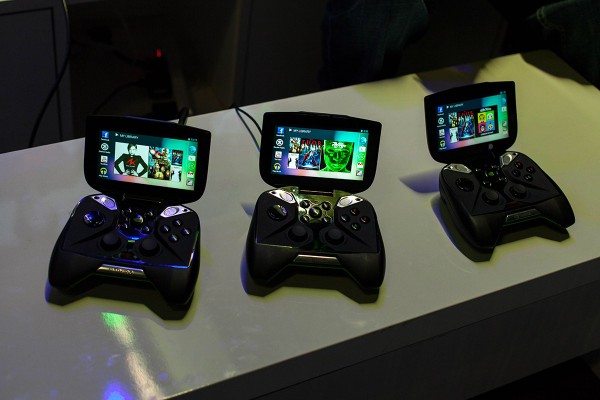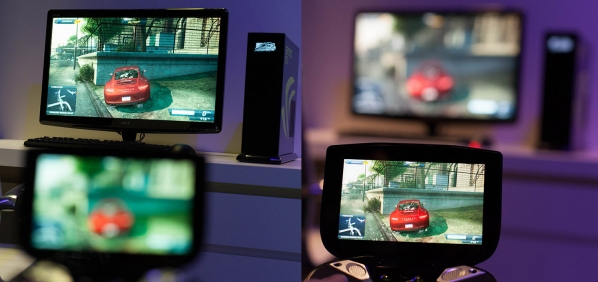
Nvidia Project Shield Hands-On Impressions [CES 2013]
At this past week’s CES, Nvidia unveiled their latest mobile processor, the TEGRA 4. However, what really made headlines wasn’t the processor itself, but what they were putting it in. In a surprising move, the chipmaker announced a mobile gaming system dubbed “Project Shield.”
We took you through the basics of the new handheld after it was announced, however, specs and numbers can only tell us so much. So on the last day of the event, I had a chance to go behind closed doors and actually spend some time with the new device, and test it out for myself.
The Shield was a little larger than an Xbox 360 controller, and felt as though it weighed roughly the same as well. When I inquired, the representative from Nvidia confirmed that they were targeting a weight of a pound or less. When I first looked at the controller portion, I honestly didn’t think it would be the most comfortable to hold. However, it did feel just fine in my hands. My only complaint was that the analog sticks could have been moved forward just a bit. One of my friends who was also testing out a unit at the same time has small hands, and complained that it was difficult to reach both the sticks and triggers at the same time. Hopefully this is something that can be improved before it ships.
On the back I found three simple ports, in addition to the trigger and bumper buttons. There’s a mini HDMI, miniUSB, and a standard headphone jack. Nvidia promised a microSD slot for additional storage, however, I didn’t see it on the device I tested. It’s possible that it was either hidden, or was left out of this prototype device.
When I first picked up the Shield, it was displaying the default interface. You’ll notice that while it is running Android, the interface has been custom-designed by Nvidia for the handheld. It was simple enough to navigate the different screens, and had a design that was reminiscent of the current Xbox 360 dashboard. While I would have liked to spent more time just testing out the various areas of the interface, what I really wanted was to test out the gameplay.
I spent a short time playing a few different TEGRA-optimized games that were pre-installed, including HAWKEN. As expected, these played smoothly, and the controls felt tight. During gameplay, I still felt that the analog sticks could have used slightly different placement. Otherwise, I felt that I could use it comfortably for hours. The very thin 5-inch screen displayed images that were bright and crisp, and at no point did I see any indication of stuttering during gameplay. Sadly, the unit I was testing was experiencing issues with audio output, so I can’t comment one way or another on sound quality.
To be perfectly honest, the feature that I was most excited to try out was the ability to stream a game from a PC. In case you missed it, if your desktop has a Keplar-based GPU (GTX 650 or higher, laptops will require a 660M or higher), you can actually stream a game from your desktop, and play it on the Shield. Everything will be rendered on your PC, with only the video being streamed to the handheld. This will also boost your battery life, since all of the work is being done elsewhere.
For the demo, Nvidia had Need for Speed: Most Wanted installed on a desktop machine located near the testing area. Upon launching it through the Shield’s interface, you could see the game being displayed on both devices. I could actually watch the PC’s monitor and play the game, and see the exact same thing on the Shield. There did not appear to be any noticable lag in either control inputs, or display. I actually spent a short time watching both screens, and could not see any difference on what was being displayed. Needless to say, I was impressed.
As stated during Nvidia’s press conference, the device is slated to ship in Q2 of this year, and our representative said that they hoped to have it on shelves before E3. What they would not discuss were their intentions for pricing. They said that they did want to be as aggressive as possible, however, unlike most consoles and even handhelds like the PS Vita and 3DS, Nvidia would not be trying to sell the device at a loss. The reason is that companies like Sony and Nintendo are able to recoup those losses when games are purchased. Nvidia has no way to do this, as they are not a game publisher.
We were told that Nvidia is carefully listening to feedback regarding potential prices, and they are considering ideas such as offering lower storage space on the device, in order to drive down cost. With the inclusion of a microSD slot (which they did announce), this is something that I would personally be very happy with. When asked what I thought their target price should be, and what I thought they would actually price it at, I responded with $300 and $500, respectively. While they put on their best poker faces, I was told that these same numbers were popular responses that they had received. We should hear official prices sometime in the coming months.
My overall impression with Project Shield is a positive one. This device could very well be the biggest thing to happen to the handheld gaming market since Apple released the iPhone. The iPhone was the first to put a handheld gaming device into the hands of millions of non-gamers. Now, Nvidia is making a device that puts PC-quality, and even actual PC games into your hands. The only real issue I see here is price.
If the Shield isn’t priced aggressively enough, it could easily pass into obscurity. You have to keep in mind that one of the best features of this handheld disappears once you leave the house. Yes, there are going to be Tegra-optimized Android games that will be considerably more fun on the Shield, but I think that true mass-development of these more serious games will depend on how well this particular device sells. There is also the question of cloud-based gaming, which the company has a vested interest in. The coming months should prove interesting ones for Nvidia.
























